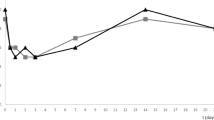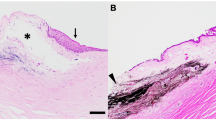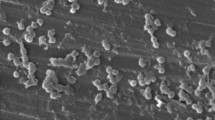Abstract
Gene transfer is considered to be a promising alternative for the treatment of several chronic diseases that affect the ocular surface. The goal of the present work was to investigate the efficacy and mechanism of action of a novel DNA nanocarrier made of hyaluronan (HA) and chitosan (CS), specifically designed for topical ophthalmic gene therapy. With this goal in mind, we first evaluated the transfection efficiency of the plasmid DNA-loaded nanoparticles in a human corneal epithelium cell model. Second, we investigated the bioadhesion and internalization of the nanoparticles in the rabbit ocular epithelia by confocal laser scanning microscopy. Third, we determined the in vivo efficacy of these nanocarriers in terms of their ability to transfect ocular tissues. The results showed that HA–CS nanoparticles and, in particular, those made of low molecular weight CS (10–12 kDa), led to high levels of expression of secreted alkaline phosphatase in the human corneal epithelium model. In addition, we observed that, following topical administration to rabbits, these nanoparticles entered the corneal and conjunctival epithelial cells and, then, become assimilated by the cells. More importantly, these nanoparticles provided an efficient delivery of the associated plasmid DNA inside the cells, reaching significant transfection levels. Therefore, we conclude that these nanoparticles may represent a new strategy toward the gene therapy of several ocular diseases.
This is a preview of subscription content, access via your institution
Access options
Subscribe to this journal
Receive 12 print issues and online access
$259.00 per year
only $21.58 per issue
Buy this article
- Purchase on Springer Link
- Instant access to full article PDF
Prices may be subject to local taxes which are calculated during checkout






Similar content being viewed by others
References
Borrás T . Recent developments in ocular gene therapy. Exp Eye Res 2003; 76: 643–652.
Pleyer U, Ritter T . Gene therapy in immune-mediated diseases of the eye. Prog Retin Eye Res 2003; 22: 277–293.
Patil SD, Rhodes DG, Burgges DJ . DNA-based therapeutics and DNA delivery systems: a comprehensive review. AAPS J 2005; 7: 61–77.
Klausner EA, Peer D, Chapman RL, Multack RF, Andurkar SV . Corneal gene therapy. J Control Release 2007; 124: 107–133.
Bennett J, Maguire AM . Gene therapy for ocular disease. Mol Ther 2000; 1: 501–505.
Martin KRG, Klein RL, Quigley HA . Gene delivery to the eye using adeno-associated viral vectors. Methods 2002; 28: 267–275.
Mohan RR, Sharma A, Netto MV, Sinha S, Wilson SE . Gene therapy in the cornea. Prog Retin Eye Res 2005; 24: 537–559.
Al-khatiba K, Williamsb BRG, Silvermanb RH, Halfordc W, Carra DJJ . Dichotomy between survival and lytic gene expression in RNase L- and PKR-deficient mice transduced with an adenoviral vector expressing murine IFN-b following ocular HSV-1 infection. Exp Eye Res 2005; 80: 167–173.
Lai L-J, Xiao X, Wu JH . Inhibition of corneal neovascularization with endostatin delivered by adeno-associated viral (AVV) vector in a mouse corneal injury model. J Biomed Sci 2007; 14: 313–322.
Porteus MH, Connelly JP, Pruett SM . A look to future directions in gene therapy research for monogenic diseases. PLoS Genet 2006; 2: 1285–1292.
Farjo R, Skaggs J, Quiambao AB, Cooper MJ, Naash MI . Efficient non-viral ocular gene transfer with compacted DNA nanoparticles. PLoS ONE 2006; 20: 1–8.
Fattal E, Bochot A . Ocular delivery of nucleic acids: antisense oligonucleotides, aptamers and siRNA. Adv Drug Deliver Rev 2006; 58: 1203–1223.
Sánchez A, Alonso MJ . Nanoparticular carriers for ocular drug delivery. In: Torchilin VP (ed.). Nanoparticulates as Drug Carriers. Imperial College Press: London, UK, 2006, pp 649–673.
Calvo P, Thomas C, Alonso MJ, Vila-Jato JL, Robinson JR . Study of the mechanism of interaction of poly-ɛ-caprolactone nanocapsules with the cornea by confocal laser scanning microscopy. Int J Pharm 1994; 103: 283–291.
De Campos AM, Diebold Y, Carvalho ELS, Sánchez A, Alonso MJ . Chitosan nanoparticles as new ocular drug delivery systems: in vitro stability, in vivo fate and cellular toxicity. Pharm Res 2004; 21: 803–810.
Losa C, Alonso MJ, Vila-Jato JL, Orallo F, Martínez J, Saavedra JA et al. Reduction of cardiovascular size effects associated with ocular administration of metipranolol by inclusion in polymeric nanocapsules. J Ocul Pharmacol Ther 1992; 8: 191–198.
Fagerholm P . Endogenous hyaluronan in the anterior segment of the eye. Prog Retin Eye Res 1996; 15: 281–296.
Aragona P . Hyaluronan in the treatment of ocular surface disorders. In: Garga HG, Hales CA (eds.). Chemistry and Biology of Hyaluronan. Elsevier Ltd.: Oxford, UK, 2004, pp 529–551.
Menzel EJ, Farr C . Hyaluronidase and its substrate hyaluronate: biochemistry, biological activities and therapeutic uses. Cancer Lett 1998; 131: 3–11.
Zhu S-N, Nölle B, Duncker G . Expression of adhesion molecule CD44 in human corneas. Br J Ophthalmol 1997; 81: 80–84.
Lerner LE, Schwartz DM, Hwang DG, Howes L, Stern R . Hyaluronan and CD44 in the human cornea and conjunctiva. Exp Eye Res 1998; 67: 481–484.
Alonso MJ, Sánchez A . The potential of chitosan in ocular drug delivery. J Pharm Pharmacol 2003; 55: 1451–1463.
De Campos A, Sánchez A, Gref R, Calvo P, Alonso MJ . The effect of a PEG vs a chitosan coating on the interaction of drug colloidal carriers with the ocular mucosa. Eur J Pharm Sci 2003; 20: 73–81.
Calvo P, Remuñán-López C, Vila-Jato JL, Alonso MJ . Novel hydrophilic chitosan-polyethylene oxide nanoparticles as protein carriers. J Appl Polym Sci 1997; 63: 125–132.
De la Fuente M, Seijo B, Alonso MJ . Novel hyaluronan based nanocarriers for transmucosal delivery of macromolecules (accepted, doi:10.1002/mabi.200700190).
Hornof M, Toropainen E, Urtti A . Cell culture models of the ocular barriers. Eur J Pharm Biopharm 2005; 60: 207–225.
Toropainen E, Hornof M, Kaarniranta K, Johansson P, Urtti A . Corneal epithelium as a platform for secretion of transgene products after transfection with liposomal gene eyedrops. J Gene Med 2007; 9: 208–216.
Calvo P, Alonso MJ, Vila-Jato JL, Robinson JR . Improved ocular bioavailability of indomethacin by novel ocular drug carriers. J Pharm Pharmacol 1996; 48: 1147–1152.
Rabinovich-Guilatt L, Couvreur P, Lambert G, Dubenert C . Cationic vectors in ocular drug delivery. J Drug Target 2004; 12: 623–633.
Toropainen E, Ranta V-P, Talvitie A, Suhonen P, Urtti A . Culture model of human corneal epithelium for prediction of ocular drug absorption. Invest Ophthalmol Vis Sci 2001; 42: 2942–2948.
Köping-Höggård M, Vårum KM, Issa M, Danielsen S, Christensen BE, Stokke BT et al. Improved chitosan-mediated gene delivery based on easily dissociated chitosan polyplexes of highly defined chitosan oligomers. Gene Therapy 2004; 11: 1441–1452.
Richardson SCW, Kolbe HVJ, Duncan R . Potential of low molecular mass chitosan as a DNA delivery system: biocompatibility, body distribution and ability to complex and protect DNA. Int J Pharm 1999; 178: 231–243.
Evanko SP, Wight TN . Intracellular localization of hyaluronan in proliferating cells. J Histochem Cytochem 1999; 47: 1331–1341.
Duverger E, Pellerin-Mendes C, Mayer R, Roche AC, Monsigny M . Nuclear import of glycoconjugates is distinct from the classical NLS pathway. J Cell Sci 1995; 108: 1325–1332.
Ito T, Iida-Tanaka N, Niidome T, Kawano T, Kubo K, Yoshikawa K et al. Hyaluronic acid and its derivative as a multi-functional gene expression enhancer: protection from non-specific interactions, adhesion to targeted cells and transcriptional activation. J Control Release 2006; 112: 382–388.
De la Fuente M, Seijo B, Alonso MJ . Novel hyaluronic acid-chitosan nanoparticles for ocular gene therapy (in press).
Culty M, Nguyen HA, Underhill CB . The hyaluronan receptor (CD44) participates in the uptake and degradation of hyaluronan. J Cell Biol 1992; 116: 1055–1062.
Schwartz DM, Jumper MD, Lui G-M, Dang S, Schuster S, Stern R . Corneal endothelial hyaluronidase: a role in anterior chamber hyaluronic acid catabolism. Cornea 1997; 16: 188–191.
Csoka AB, Frost GI, Stern R . The six hyaluronidase-like genes in the human and mouse genomes. Matrix Biol 2001; 20: 499–508.
Masuda I, Matsuo T, Yasuda T, Matsuo N . Gene transfer with liposomes to the intraocular tissues by different routes of administration. Invest Ophthalmol Vis Sci 1996; 37: 1914–1920.
Liaw J, Chang SF, Hsiao FC . In vivo gene delivery into ocular tissues by eye drops of poly(ethylene oxide)-poly(propylene oxide)-poly(ethylene oxide) polymeric micelles. Gene Therapy 2001; 8: 999–1004.
Janes K, Alonso MJ . Depolymerized chitosan nanoparticles for protein delivery: preparation and characterization. J Appl Polym Sci 2003; 88: 2769–2776.
De Belder AN, Wik KO . Preparation and properties of fluorescein-labelled hyaluronate. Carbohydr Res 1975; 44: 251–257.
Acknowledgements
This work has been supported by the Spanish Ministry of Science and Technology (MAT 2004-04792-C02-02; NAN 2004-09230-C04-04). The first author acknowledges a grant from the Spanish Government (FPU-MEC). We thank Elisa Toropainen and Margit Hornof for their help in the development of the HCE model, and Rafael Romero for his help with the manipulation of animals.
Author information
Authors and Affiliations
Corresponding author
Rights and permissions
About this article
Cite this article
de la Fuente, M., Seijo, B. & Alonso, M. Bioadhesive hyaluronan–chitosan nanoparticles can transport genes across the ocular mucosa and transfect ocular tissue. Gene Ther 15, 668–676 (2008). https://doi.org/10.1038/gt.2008.16
Received:
Revised:
Accepted:
Published:
Issue Date:
DOI: https://doi.org/10.1038/gt.2008.16
Keywords
This article is cited by
-
Directing the Way—Receptor and Chemical Targeting Strategies for Nucleic Acid Delivery
Pharmaceutical Research (2023)
-
Biopolymer-based nano-formulations for mitigation of ocular infections: a review
Polymer Bulletin (2023)
-
Analysis of the formation mechanism of polyion complexes of polysaccharides by molecular dynamics simulation with oligosaccharides
Polymer Journal (2022)
-
Antimicrobial and cytotoxic activity of electrosprayed chitosan nanoparticles against endodontic pathogens and Balb/c 3T3 fibroblast cells
Scientific Reports (2021)
-
Polymeric nanocapsules: a potential new therapy for corneal wound healing
Drug Delivery and Translational Research (2016)



